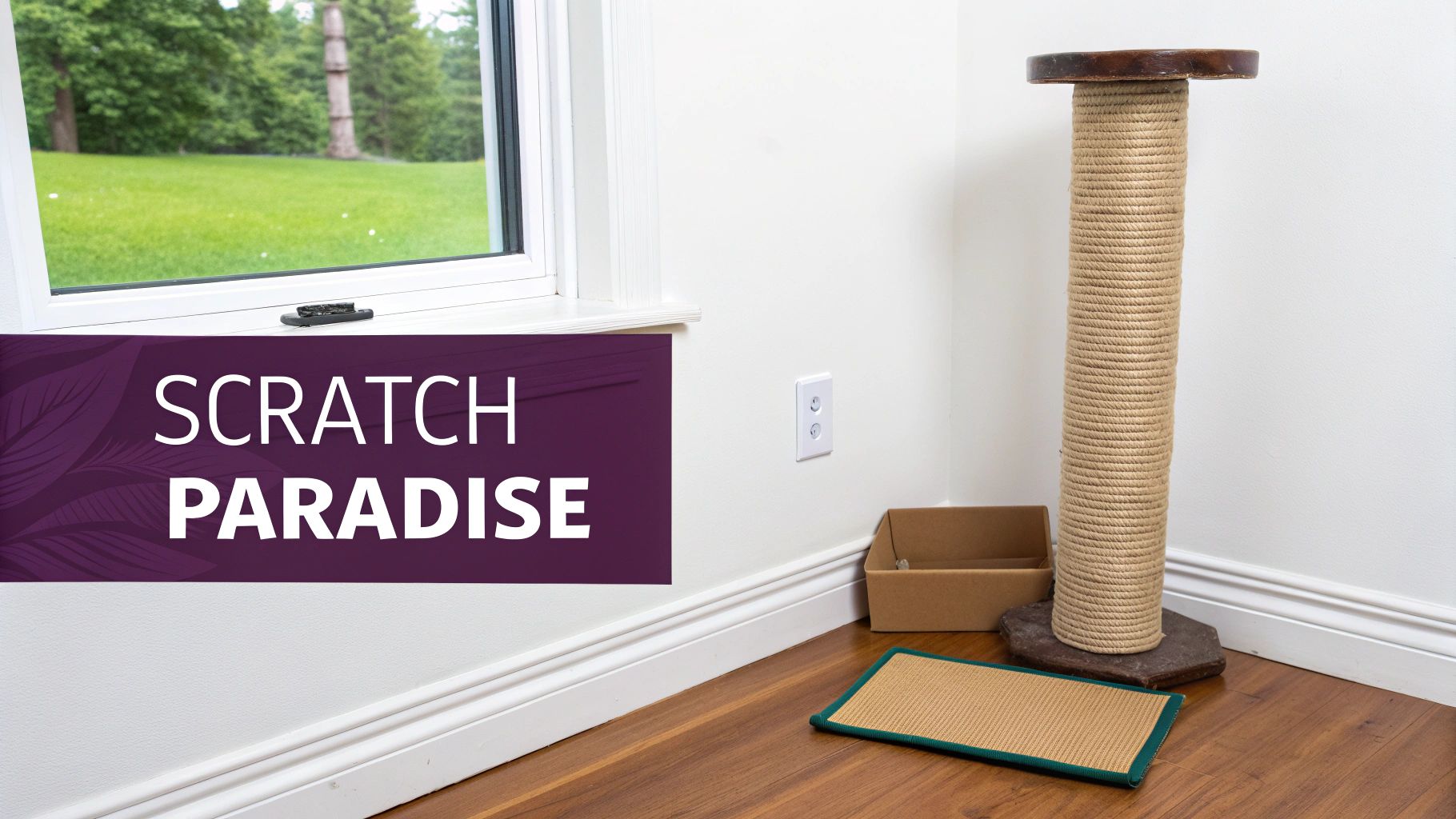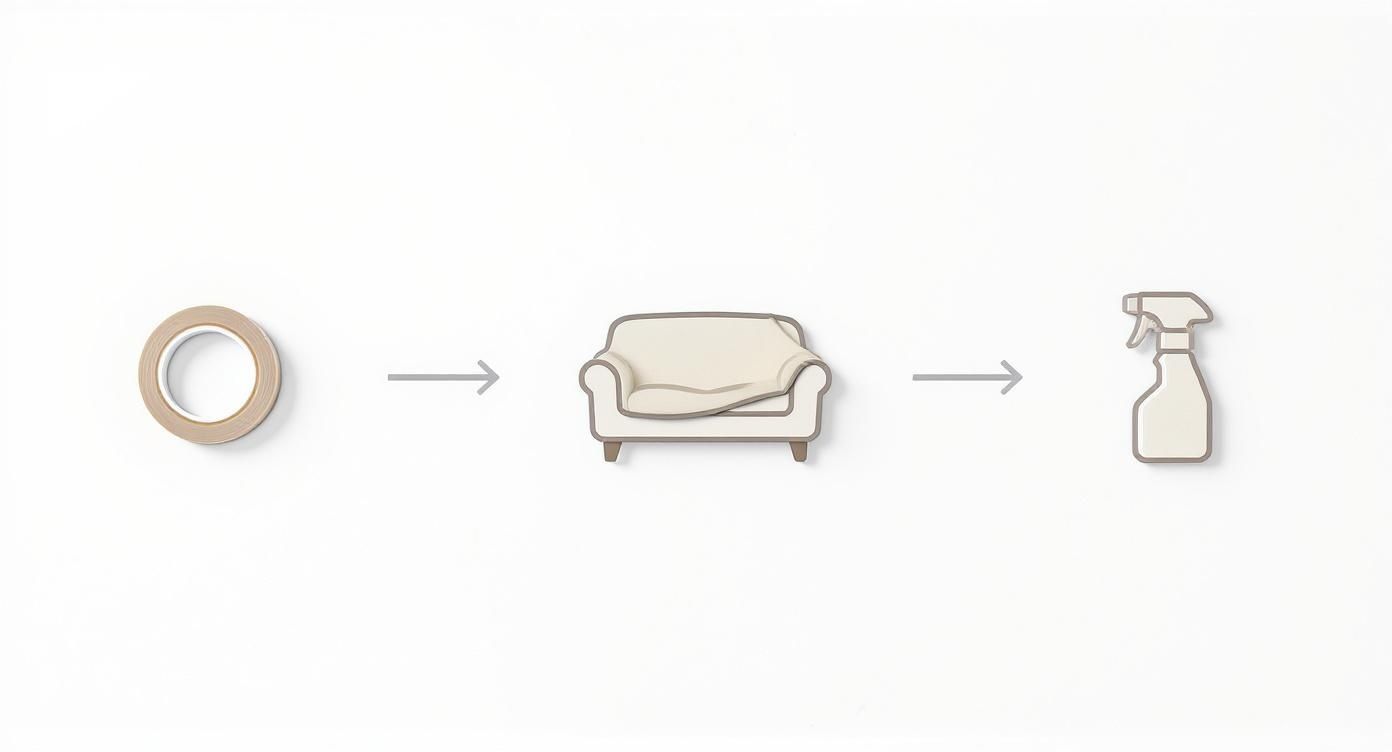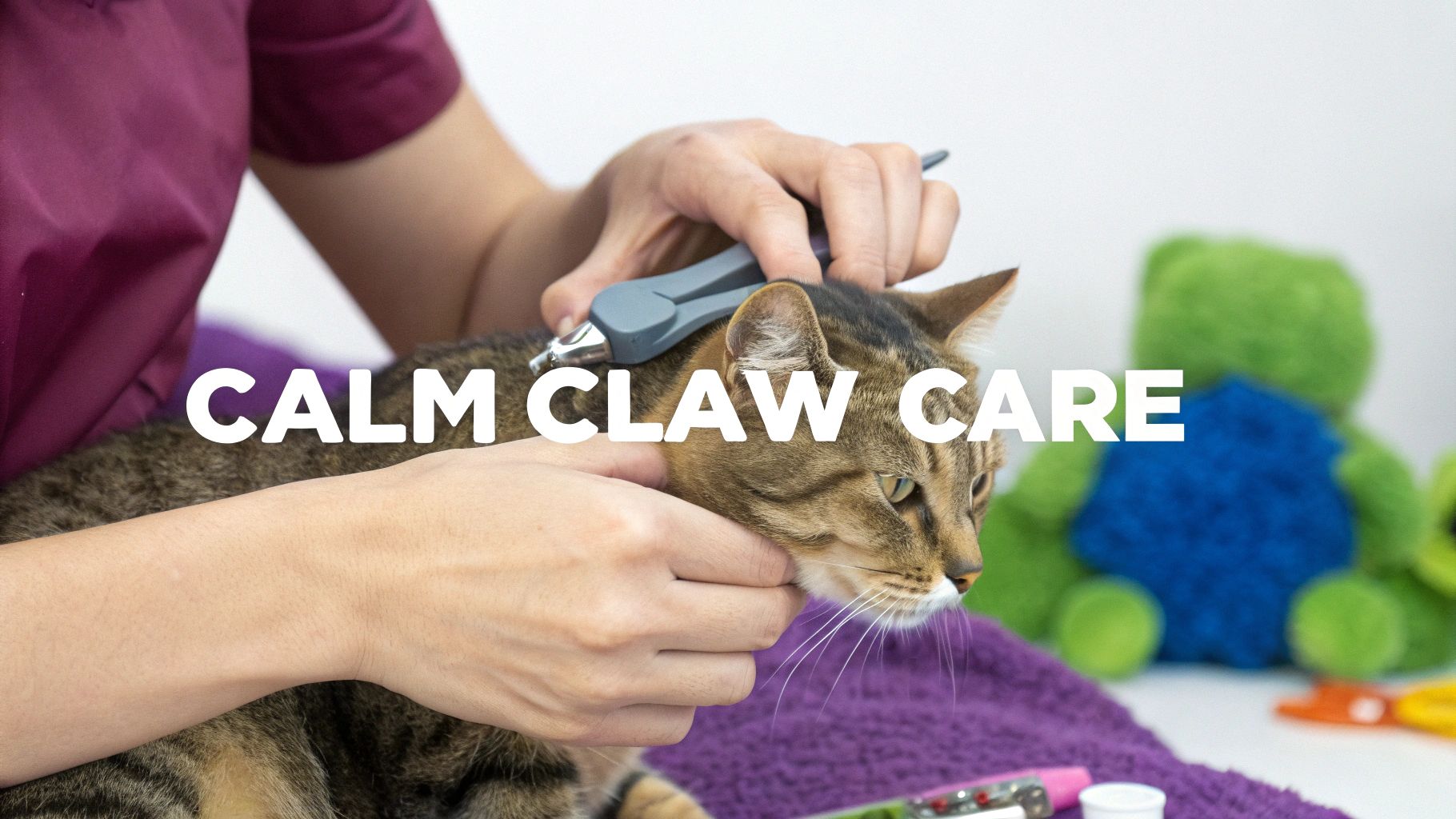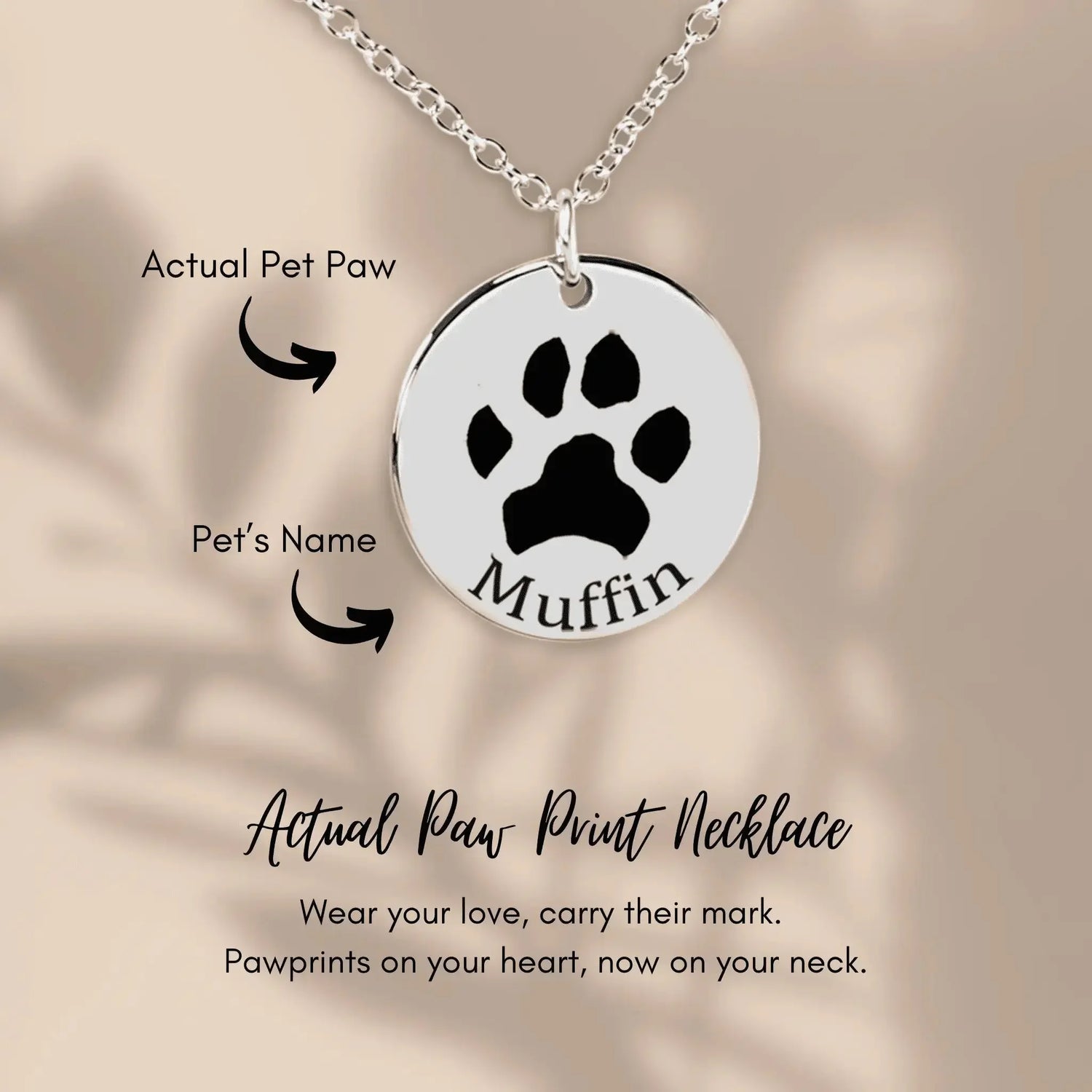How to Stop Cat Scratching Furniture: A Fur-bulous Guide 🐾

If you want to stop your cat from scratching your purr-ecious furniture, you need a solid game plan. It’s a two-pronged attack: make your furniture a totally unappealing place to scratch, while at the same time, offering up an irresistible alternative like a super-sturdy scratching post.
This strategy is all about redirecting that natural scratching instinct—which is non-negotiable for their health and happiness—away from your sofa and onto something you approve of. Remember, we're working with your cat's instincts, not punishing them! Let's get this paw-ty started! 🎉
Unraveling the Great Scratching Mystery

So, your beautiful sofa now looks like a modern art installation made of shredded fabric? Welcome to the club, fellow cat parent! You've definitely landed in the right spot.
Our mascot, Floofie, wants you to know a little secret: your cat isn't scratching your furniture out of spite. It’s a completely natural, instinctual behavior that’s absolutely crucial for their well-being. 😼
Think of it as their daily self-care routine. Those long, satisfying stretches against the arm of your chair are the feline version of a full-body yoga session. It keeps their back and shoulder muscles loose and limber.
But it’s about more than just a good stretch. Let's break down the main reasons behind this claw-some behavior.
A Kitty Manicure Session
Scratching is how cats keep their claws healthy. The action helps them shed the dead outer layer of their nails, which keeps them sharp and ready for important business (like pouncing on their favorite UFO cat toy). Without a good surface to scratch, their nails can get overgrown and uncomfortable.
Leaving Their Scent Signature
Did you know cats have tiny scent glands in their paws? 🐾 When they scratch, they leave behind their own unique scent—a little "Floofie was here" message. It’s their way of marking territory and making a space feel safe and familiar. This is a powerful form of communication that helps them feel secure at home.
So, if you're wondering why your cat is scratching the furniture, it's not because you have a naughty kitty. It's just a fundamental part of being a cat. And if your furniture is the main target, you are far from alone.
A detailed survey found that scratching stuff they shouldn't is incredibly common. In fact, 83.9% of cats were reported to scratch inappropriate items. Furniture like chairs and sofas were the top choice, with 81.5% of cats picking them for their daily claw maintenance. You can read the full research about these feline habits for more details.
Understanding these natural drives is the first and most important step. Once you get the why, you can start giving them better whats and wheres to scratch. Up next, we’ll dive into how to create a scratching paradise your cat will choose over your couch every single time! 💖
Creating A Scratch-Worthy Environment

Ready to outsmart your furry little furniture destroyer? The secret isn't to stop the scratching—it's to give them something way, way better to sink their claws into. Let’s build them a scratching paradise they can’t possibly ignore! 😻
Our mascot, Floofie, firmly believes that variety is the spice of life. A single, wobbly scratching post tucked away in a corner just isn't going to cut it. To successfully redirect your cat, you need to think like a cat and load up their environment with irresistible options.
This means offering a mix of surfaces, angles, and locations. A solid cat tree is a fantastic start, but if you're not a fan of DIY, getting help with assembling a cat tree can ensure it's sturdy and safe from day one.
Picking The Purrfect Materials
Not all scratching surfaces are created equal in a cat's eyes. While your leather armchair might have a certain appeal, some materials are universally adored by felines. The goal is to find textures that offer a deeply satisfying shredding experience.
Here are a few Floofie-approved materials that are practically cat magnets:
- Sisal Rope: This is the gold standard for a reason. Its rough, durable texture is perfect for digging claws into and getting a deep, satisfying scratch. A great example is our cactus cat scratcher tree.
- Corrugated Cardboard: Cheap, cheerful, and oh-so-shreddable! Cats love the sound and feel of tearing into cardboard, making those horizontal scratching pads a huge hit.
- Sturdy Carpet: A sturdy, low-pile carpet on a post can feel similar to the furniture they already love, making it an easy switch for them to make.
- Natural Wood: For the kitty who loves the great outdoors, a solid wood or bark-covered post can be an exciting and unique treat for their claws.
Having a few of these around means there's always something to match your cat's mood. One day they might feel like shredding cardboard to bits, and the next they might want a good stretch on a tall sisal post.
Here’s a quick-glance table to help you find the perfect match for your kitty's scratching style.
Floofie's Top Scratcher Picks for Every Cat
Use this comparison to find the perfect scratching solutions based on your cat's unique personality and habits.
| Scratcher Type | Best For... | Top Material | Floofie's Pro Tip |
|---|---|---|---|
| Vertical Post | Cats who love to stretch tall while scratching ("tree-climbers"). | Sisal Rope | Make sure it's tall enough for a full stretch and has a heavy base so it won't wobble. |
| Horizontal Pad | Cats who prefer scratching on the ground, like rugs or doormats. | Corrugated Cardboard | Place these in high-traffic areas. They're inexpensive, so you can sprinkle them around the house! |
| Cat Tree / Condo | Households with multiple cats or kitties who love to climb, perch, and scratch all in one spot. | Sisal & Carpet | A multi-level tree with different textures provides the ultimate enrichment playground. |
| Incline Scratcher | Cats who like to scratch at an angle; a great compromise between vertical and horizontal preferences. | Cardboard or Wood | Position it near furniture they've been eyeing to offer a satisfyingly similar angle. |
Hopefully, this gives you a great starting point for turning your home into a scratch-friendly zone!
Location, Location, Location
You could buy the world’s most luxurious cat tree, but if you hide it in the basement, your cat is going to give it the cold shoulder. Strategic placement is everything. Think about your cat’s daily routine and place scratchers in high-traffic areas they already love.
A key strategy is to place a new, desirable scratching post directly next to the piece of furniture your cat is currently targeting. This makes the "right" choice the easiest and most convenient one for them to make.
Consider these prime real estate spots:
- Next to their favorite napping spots for a post-snooze stretch.
- Near windows where they watch birds and get all excited.
- At the entrances to rooms, where they often mark their territory.
Investing in these solutions is a popular and effective strategy. The global market for cat furniture and scratchers was valued at around USD 1.3 billion in 2024 and is expected to more than double by 2035. Clearly, a lot of pet parents are choosing enrichment over frustration!
For those looking to combine function with style, you're in luck. There's no need to sacrifice your home decor. Check out our guide to modern cat trees and furniture that both you and your cat will adore.
Make Your Furniture a Total Snooze-Fest
Alright, you’ve successfully created a five-star scratching paradise for your cat. Now for the other half of the plan: we need to make your actual furniture as unappealing as possible for a kitty manicure. The goal here isn’t to punish, but to gently convince them that your sofa is, frankly, boring. 🛋️
The strategy is pretty simple. We're going to make the forbidden surfaces feel, look, or smell weird to your cat, while their designated scratching spots remain the coolest places in the house. It's all about making the right choice the easiest and most satisfying choice.
Let's turn that couch into a certified no-claw zone.
Sticky Situations and Smart Shields
One of the quickest ways to deter a cat is to change the texture of the surface they’re scratching. Cats are big on texture, and they really, really hate the feeling of anything sticky on their paws. This is where you can get clever.
A classic trick is double-sided sticky tape. You can find products made specifically for this, like Sticky Paws Furniture Strips. Just apply a few strips to the corners of the couch or the legs of a chair they’ve been targeting. The second their paw touches that tacky surface, they'll likely pull back with a look of pure disgust. Mission accomplished.
If you're looking for something a bit more permanent and less, well, sticky, check out clear furniture shields. These are basically invisible plastic panels that stick right onto your furniture, whether it's fabric or leather. They create a slick, smooth surface that a cat can't get their claws into, making scratching completely unsatisfying. A pack of Panther Armor Furniture Protectors can guard those vulnerable corners without being an eyesore.
Floofie's Top Tip: Never underestimate the power of a good disguise! A thick, stylish slipcover can be a total game-changer. Look for durable, tightly woven fabrics like canvas, denim, or microfiber that are tough for claws to snag.
Use Their Super-Sniffer to Your Advantage
A cat's sense of smell is a superpower—it’s about 14 times stronger than ours! We can use this to create an invisible forcefield around our furniture using scents they naturally dislike.
Citrus is the go-to scent for repelling cats. A light spritz of a pet-safe, citrus-scented spray where they tend to scratch can work wonders. You can find pre-made options like the Bodhi Dog Not Here! Spray, which uses harmless scents that pets just don't like. Just be sure to test it on a small, hidden spot of your furniture first to make sure it doesn't cause any discoloration.
Here are a few scents that most cats will turn their noses up at:
- Citrus: Lemon, orange, and grapefruit are all major turn-offs.
- Lavender: While we find it calming, many cats find the smell overpowering.
- Rosemary: Another herbaceous scent that cats often choose to avoid.
Remember, the whole point is to make the couch less fun, which in turn makes their awesome new scratching post the obvious winner. When you combine these deterrents with the fantastic scratching environment you've built, you're setting everyone up for success. 🎉
Using Positive Reinforcement and Redirection
Forget scolding your cat for scratching the furniture—it just doesn't work. Instead, let's turn this training mission into a super fun bonding experience! 💖 The real secret to teaching your cat where to scratch is making the right choice the most exciting, rewarding option in the room.
This is where positive reinforcement and gentle redirection become your superpowers. We're not going to focus on the "no." We're going to create a giant, sparkly "YES!" around their new scratching posts. The goal is simple: make their designated scratching spot the absolute coolest place to be.
Make the Scratcher an Attraction
Your cat’s new sisal post might look great to you, but to your kitty, it’s just a weird new object standing in the corner. We need to give it some pizzazz!
Start by sprinkling a little catnip or silver vine on and around the base. These scents are naturally irresistible to most cats and will get them to investigate. Then, grab their favorite toy—a feather wand works wonders—and dangle it around the post. Encourage them to pounce and grab at it, getting them to interact with the new object in a fun, low-pressure way.
The instant their claws touch the post—even if it's by accident during play—shower them with praise! Use an excited, happy voice and immediately offer a delicious treat. This creates a powerful positive association: "When my claws touch this thing, good stuff happens!"
Reward the Right Behavior
Timing is everything. You have to reward the exact moment your cat interacts correctly with the scratcher for the connection to stick.
Keep a stash of their favorite high-value treats nearby for this very purpose. The second you see them giving the post a good, intentional scratch, praise them enthusiastically ("Good kitty! What a good scratch!") and toss them a reward.
Need some ideas on what treats work best? We've got you covered in our guide to the best cat treats for training. Consistency is key here. It teaches them that scratching the post earns them something wonderful, while scratching the sofa earns them... well, nothing.
This positive approach works even better when you also make the furniture a less appealing option.

As you can see, using things like sticky tape, covers, and sprays makes the couch unappealing, which naturally drives your cat toward the much more rewarding scratching post you've set up.
Gently Redirect the Wrong Move
So, what happens when you catch your kitty in the act of shredding your new armchair? The most important thing is to stay calm. Shouting or making loud noises will only create fear and anxiety, which can actually make the behavior worse.
Instead, make a soft, attention-grabbing sound, like a gentle clap or a quick "ah-ah!" noise.
The moment they pause, calmly lead them over to their scratching post. You can use a toy to guide them, or simply pick them up and place them next to it. Once they're there, encourage them to engage with the correct item. Be ready with that praise and a treat the moment they do. 🐾
Promoting Calmness and Proper Claw Care

Sometimes, a shredded sofa is more than just a naughty habit—it can be a furry cry for help. If your cat’s scratching seems excessive, it might be a sign of underlying stress or boredom. Floofie agrees: a happy, zen kitty is far less likely to take their frustrations out on your home decor. 😌
Creating a calm, enriching environment is a huge piece of the puzzle. This strategy gets to the root cause of anxiety-driven scratching, not just the symptom. It all starts with one of the most practical steps in claw management: regular nail trims.
Keep Those Claws in Check
Dull claws are less destructive claws! Keeping your cat's nails trimmed is a simple, effective way to minimize potential damage. When their claws are shorter, they can't hook into fabric as easily, making the act of scratching your furniture far less satisfying for them.
Think of it as a kitty manicure that protects your belongings. Most vets recommend trimming at least once a month.
- Choose the right tool: Human clippers can split a cat's nail. Ouch. Instead, opt for a pair of guillotine-style or scissor-style cat nail clippers designed specifically for their unique claw shape.
- Create positive vibes: Introduce the clippers slowly. Let your cat sniff them, then touch them to their paws without clipping, and immediately follow up with a high-value treat.
- One paw at a time: Don't try to get all the nails at once, especially at first. If your cat is only comfortable with you trimming one or two claws in a sitting, that's a huge win!
A calm trimming session can actually be a great bonding moment. If you're nervous, your vet or a professional groomer can give you a quick tutorial to build your confidence.
Creating a Zen Zone for Your Kitty
Beyond nail care, fostering a serene environment is crucial. Cats thrive on routine and predictability. A chaotic home can lead to a stressed-out kitty, and a stressed-out kitty often looks for an outlet—like your favorite armchair.
This is backed by science; research often shows that cats scratch furniture as a stress response. Cats in homes with unpredictable routines or high activity levels are significantly more prone to scratching household items.
Floofie's Pro Tip: A tired cat is a happy cat! Regular, interactive playtime helps burn off excess energy and stress. Use puzzle feeders to engage their minds and make mealtime an exciting challenge instead of a two-second gulp-fest.
Establishing predictable daily routines for feeding and playing helps your cat feel secure. You can also introduce calming pheromone diffusers, like the highly-recommended Feliway Classic Diffuser Kit, which mimics natural feline "happy messages" to reduce anxiety. Check out our detailed guide on https://floofchonk.com/blogs/floofies-blog-posts/how-to-reduce-cat-anxiety for more amazing tips.
And while you're managing the scratching, it's also smart to think about your home's defenses. Choosing pet-friendly flooring that can handle paws and claws can make a world of difference. Ultimately, a relaxed environment plus a little bit of claw care can go a long way in your journey to stop your cat from scratching furniture for good.
Common Cat Scratching Questions Answered
Still wrestling with a few questions about your cat's personal vendetta against your sofa? Don't worry, you're not alone. We've gathered some of the most common head-scratchers from cat parents just like you to get you the answers you need. 🐾
Should I Consider Declawing My Cat to Save My Furniture?
Let’s be crystal clear on this one: absolutely not. Floofie is putting all four paws down! Declawing isn't just a nail trim; it's a major, painful surgery that amputates the last bone of each toe. It's widely considered inhumane by vets everywhere for a very good reason.
This procedure can sentence your cat to a lifetime of problems, including chronic pain, arthritis, and even new behavioral issues like biting because they feel defenseless. The positive, humane methods we've covered in this guide are far more effective for managing scratching without ever harming your furry best friend.
Why Does My Cat Ignore the New Scratching Post?
Ah, the classic kitty snub. You bring home a beautiful new present, and they'd rather play with the box it came in. We've all been there! If your cat is giving their fancy new sisal scratching post the cold shoulder, there are a few things to investigate.
First, give it a good shake. Does it wobble? Cats absolutely hate wobbly posts because they don’t feel secure when they put their weight into a good stretch and scratch. Next, think about the material and angle. Your cat might secretly be dreaming of a horizontal cardboard scratcher instead of a vertical sisal one. Sometimes, variety is the key to their heart.
Here's a pro tip: Location is everything. You can't just stick the post in an out-of-the-way corner and hope for the best. The single most effective spot is right next to the piece of furniture they're already scratching. Make the right choice the easy choice!
Finally, you have to sell it! Rub some catnip on it, dangle their favorite wand toy around the base, and shower them with praise and a tasty treat for any interaction at all, even just a sniff. Make it a party!
How Long Does It Take to Stop the Behavior?
This is where your patience really comes into play. Every cat learns at their own pace, so there's no magic timeline. A curious, adaptable kitten might pick up the new routine in a week, while an older, more stubborn cat with deeply ingrained habits could take a month or even longer.
The single most important factor for success is consistency. You have to stick with it. Keep applying all the strategies together—protect your furniture with deterrents, make the scratching posts the most exciting things in the room, and always, always praise your cat for making good choices. Celebrate every small victory, and you'll get there! 🎉
Now that you're armed with all the knowledge to protect your furniture and keep your kitty happy, why not treat your furry friend (or yourself!) to something special? At FloofChonk, we have everything a cat lover could dream of, from quirky apparel to innovative toys. Explore our collections today at https://www.floofchonk.com and find the purr-fect new addition to your home

